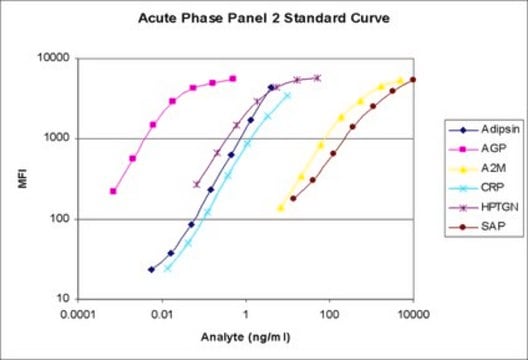MADKMAG-71K
MILLIPLEX® Mouse Adipokine Magnetic Bead Panel - Endocrine Multiplex Assay
The analytes available for this multiplex kit are: IL-6, Insulin, Leptin, MCP-1, PAI-1 (Total), Resistin, TNF-α.
Synonym(s):
luminex mouse adipokine multiplex kit, luminex mouse obesity multiplex kit, millipore mouse metabolic syndrome disease multiplex, mouse metabolism diabetes immunoassay panel
About This Item
Recommended Products
Quality Level
species reactivity
mouse
manufacturer/tradename
Milliplex®
assay range
accuracy: 77-92%
standard curve range: 12.2-50,000 pg/mL
technique(s)
multiplexing: suitable
detection method
fluorometric (Luminex xMAP)
shipped in
wet ice
General description
MILLIPLEX® Mouse Adipokine Panel is a 7-plex kit to be used for the simultaneous quantification of any or all of the following analytes in mouse serum and plasma samples: IL-6, Insulin, Leptin, MCP-1, PAI-1 Total, Resistin and TNFα. This kit uses a 96-well format, contains a lyophilized standard cocktail, two internal assay quality controls and can measure up to 38 samples in duplicate.
The Luminex® xMAP® platform uses a magnetic bead immunoassay format for ideal speed and sensitivity to quantitate multiple analytes simultaneously, dramatically improving productivity while conserving valuable sample volume.
Panel Type: Metabolism
Specificity
Each antibody pair in a panel is highly specific and displays insignificant cross-reactivity to other analytes in the panel.
Application
- Analytes: IL-6, Insulin, Leptin, MCP-1 (CCL2), PAI-1 (Total), Resistin, TNF-α
- Recommended Sample Type: Mouse serum and plasma
- Recommended Sample Dilution: 10 μL per well of undilute d serum or plasma
- Assay Run Time: Overnight (16-18 hours) at 2-8°C.
- Research Category: Metabolism
- Research Subcategory: Endocrine, Obesity, Metabolic Disorders
Features and Benefits
Other Notes
Legal Information
Disclaimer
Signal Word
Warning
Hazard Statements
Precautionary Statements
Hazard Classifications
Acute Tox. 4 Dermal - Acute Tox. 4 Inhalation - Acute Tox. 4 Oral - Aquatic Chronic 2 - Skin Sens. 1
Storage Class Code
10 - Combustible liquids
Certificates of Analysis (COA)
Search for Certificates of Analysis (COA) by entering the products Lot/Batch Number. Lot and Batch Numbers can be found on a product’s label following the words ‘Lot’ or ‘Batch’.
Already Own This Product?
Find documentation for the products that you have recently purchased in the Document Library.
Related Content
Multiplex immunoassays save time and sample volume in metabolic syndrome research, providing comprehensive insights into related conditions.
Multiplex immunoassays save time and sample volume in metabolic syndrome research, providing comprehensive insights into related conditions.
Multiplex immunoassays save time and sample volume in metabolic syndrome research, providing comprehensive insights into related conditions.
Multiplex immunoassays save time and sample volume in metabolic syndrome research, providing comprehensive insights into related conditions.
Our team of scientists has experience in all areas of research including Life Science, Material Science, Chemical Synthesis, Chromatography, Analytical and many others.
Contact Technical Service









